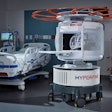Medical imaging stands at a critical crossroads. In 2025, intensifying financial pressures, evolving compliance mandates around AI and data privacy, and a deepening radiologist shortage are accelerating disruption across the field. Recent federal policy changes, regulatory uncertainty, and ongoing reimbursement cuts are compounding the strain, pushing the industry toward a decisive inflection point.
While many of these headwinds lie beyond the control of individual providers, the most resilient imaging organizations are focusing on internal transformation. Despite the challenges, the current landscape presents a rare opportunity to innovate and evolve. By leveraging strategic partnerships and advanced technologies to improve operational efficiency, medical imaging leaders can not only withstand external pressures but also position their organizations and the industry to prosper in the years ahead. Jordan Bazinsky, CEO of Intelerad
Jordan Bazinsky, CEO of Intelerad
Toward an operational crisis
Medical imaging’s economic outlook is rapidly shifting, leaving providers grappling with diminished payment rates and increased operational expenditures. Medicare reimbursement for the professional component of radiology services decreased by 3.4% in 2024 and by 2.83% in 2025.
These cuts follow a broader trend -- radiologists faced an alarming 25% drop in reimbursement rates from 2005 to 2021 -- but that doesn’t make them any less troubling. The anticipated shift in payer mix toward Medicare and Medicaid threatens to widen these deficits further.
Regulatory strain is mounting as well. Earlier this year, U.S. Food and Drug Administration (FDA) staffing cuts raised concerns about delays in imaging device approvals. Of the 40 employees reviewing imaging devices, 10 were initially let go, along with 40 from the AI research team. While a handful focused on AI-enabled imaging devices were reportedly rehired, the FDA hasn’t disclosed exact numbers.
There are tens of thousands of new medical imaging technology applications each year, so FDA staffing reductions may result in longer approval timelines and providers having limited access to new innovations needed to deliver high-quality care and fill widening staffing gaps.
Radiologists are in increasingly short supply. The number of individuals taking the American Registry of Radiologic Technologists certification exam declined by approximately 18% from 2006 to 2022.
Although numbers have rebounded marginally in the past few years, there still aren’t enough radiologists to keep pace with imaging demand, especially advanced scans like CT and MRI, which are increasing by 3% to 5% annually. The resulting bottlenecks strain existing professionals and directly impact patient care.
Conditions are ripe for a crisis, and rising regulatory requirements may be the tipping point. With the need to meet stricter standards for AI, telehealth, and data privacy, hospital and health system leaders must respond swiftly with proactive measures to stay ahead of the curve.
Boosting resilience
Addressing these challenges won’t be easy, and relying on federal and regulatory bodies to ease these pressures isn’t practical. The modest 2.25% inflation-linked update for Medicare physician payments tied to the Medicare Economic Index is a clear example. While helpful, the small adjustment won’t address deeper systemic issues, effectively delaying the fallout of an unsustainable payment model.
Instead, medical imaging providers must focus on what is within their control. Leveraging the right technology and forging solid partnerships can offset external burdens and help organizations maintain high operational standards. To streamline workflows, reduce costs, and manage increasing demands, it’s important to utilize innovative solutions and tools such as the following:
AI: AI enables radiologists to work more efficiently by simplifying a variety of tasks, such as automating reporting workflows and prioritizing exam findings based on criticality to quickly provide patients with answers. These solutions also enhance diagnostic accuracy, ensure better outcomes, and free up stretched radiology teams to focus on critical cases.
Integrated platforms: Platforms that unify disparate storage systems and data sources to keep information accessible and safe are invaluable for privacy compliance. Flexible solutions that adapt and serve enterprise-scale healthcare environments as easily as imaging centers connect teams from all clinical specialties across the care continuum.
Remote imaging and telehealth capabilities: The telehealth boom is an opportunity for radiology to expand its reach and maximize staffing resources. Investing in secure cloud-based worklists and tele-imaging platforms gives imaging specialists the freedom to read from anywhere. In addition, collaboration capabilities and instant access to patient imaging improve care coordination regardless of location.
Compliance and risk mitigation tools: Compliance surrounding federal regulations, such as HIPAA, ASRT laws, and JCI standards, and AI usage pose challenges. Technology that automates compliance monitoring and safeguards against vulnerabilities in imaging systems is becoming increasingly critical. These systems reduce regulatory risks while ensuring adherence to all policies and mandates.
Industry collaboration and trust
Beyond technology, partnerships are essential to navigating turbulent environments. Collaborative relationships with trusted medical imaging vendors, consultants, and even industry peers can help organizations of all sizes, from healthcare systems to provider practices, remain agile and innovative.
Partnering with vetted technology vendors ensures access to the latest efficiency-enhancing tools designed to be scalable, cost-effective, and compliant. It also establishes a shared responsibility for maintaining service continuity during challenging periods, such as when resources and provider teams are stretched thin.
In those instances, organizations are often tempted to outsource certain functions. While there are times when this option makes sense, imaging providers may be surprised to find that partnering with the right vendor can actually reduce the need for outsourcing and cut costs. Choosing solution providers that offer secure, centralized access to comprehensive data and regional patient records can enhance the scope of care provided remotely and boost clinical efficiency.
In addition, working closely with academic institutions can bolster the radiologist pipeline. Residency and fellowship programs that are supported by healthcare organizations can help to address the professional shortage by prioritizing foundational training and post-graduation job placement.
Medical imaging’s future
The years ahead will test the industry’s limits. Ongoing challenges like resource constraints, staff burnout, and financial pressures can be mitigated with the right innovations. In many cases, even a single high-impact upgrade can relieve pressure across the care continuum.
For instance, poor interoperability causes radiology workflow breakdowns, communication errors, and delays that damage care quality and patient trust. But through the adoption of advanced, flexible technologies, leadership teams can shore up operations and protect long-term stability. Without decisive action, however, unresolved systemic issues could lead to serious service disruptions and worsening patient outcomes.
To future-proof their operations, healthcare system executives and radiology leaders must act boldly. From AI tools to integrated solutions and trusted partnerships, every investment must drive better care, strengthen collaboration, and operational performance. The moment for transformation is not coming; it is already here.
Jordan Bazinsky is the CEO of Intelerad, a medical imaging software provider
The comments and observations expressed are those of the author and do not necessarily reflect the opinions of AuntMinnie.com.




















